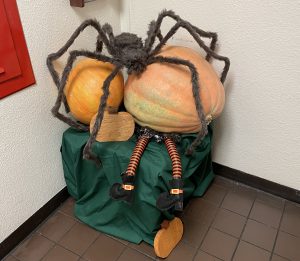On Halloween, costumed monsters will loom in the darkness of a moonless night to scare us. Equally as eerie and unsettling, Mother Nature has macabre insect and spider critters of her own.
To start with a seemingly pious bug, the praying mantis (order Mantodea), is a deadly eater and mater. With her long forelegs she captures her prey and eats them alive while holding them in a death grip. While she is mating, she bites the male’s head clean off and continues chomping until he dies. She then saunters off well fed and fertile.
The Japanese giant hornet (Vespa mandarinia japonica) is so big that, in flight, it resembles a small bird. It stings or sprays its victims—including humans—with a flesh-dissolving acid. It usually aims for the eyes. Embedded in this acid is a pheromone that attracts other hornets to the victim and they attack en masse.
Another creature to throw the most stalwart person into a state of arachnophobia (fear of spiders) or entomophobia (fear of insects) is the emerald cockroach wasp (Ampulex compressa), found in Asia and Africa. This wasp turns cockroaches into zombies by injecting venom into the victim’s brain. The wasp first jabs its stinger into the thorax of the insect then, as the cockroach protectively tucks in its chin, the wasp inserts her stinger into the insect’s head tissues, carefully maneuvering until it reaches the brain. After this ghastly operation, the cockroach is in her power and doesn’t move. She bites off the cockroach’s antenna and uses it like a leash to lead it to a safe chamber. She lays one egg in the cockroach and seals up the chamber. The poor insect is left as food for the egg when it hatches.
The botfly (family Oestridae) is another of Mother Nature’s creepy creatures. They live in Central and South America. Their larvae are internal parasites of mammals, growing in the stomach or the flesh. The botfly traps a mosquito, fly or tick and lays eggs on it. When the insect bites a mammal, the eggs are then deposited into the victim. In 2013, ABC news reported that a couple, while visiting Bolivia, were bitten by mosquitoes and assumed the raised welts were a result of the bites—until they noticed that the welts were moving.
The Goliath spider (from the tarantula family Theraphosidae) is the biggest of all spiders. They are a foot across. They hunt by weaving a mat of silk outside their lairs, sensing when a mouse or a baby bird walks over it. They have fangs about an inch long, but their bite feels more like a bee sting and there have never been human deaths reported due to their bites. They inhabit rain forests of northern South America. The local cuisine includes this spider; it is cooked by singeing off its hairs and roasting it in banana leaves.
This Halloween, no matter how frightening the costumes, they can hardly compete with Mother Nature for grizzly appearances. Of course, many bugs and spiders are beneficial for the garden and are needlessly killed by insecticides. So, let’s celebrate the beneficial and the ghastly. HAPPY HALLOWEEN!
Sources: Gudrun Herzner in the Proceedings of the National Academy of Sciences of the United States of America, vol. 110, no.4 (article and picture credit on the emerald cockroach wasp)
Amy Stewart, “Wicked Bugs: The Louse that conquered Napoleon’s Army & Other Diabolical Insects,” Algonquin Books of Chapel Hill, 2011
Francie McGowan is a former University of California Cooperative Extension Master Gardener of Tuolumne County.

